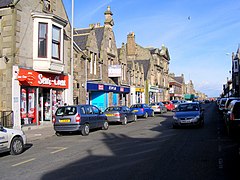Buckie
Buckie
|
|
|---|---|
 East Church Street looking eastwards |
|
| Buckie shown within Moray | |
| Population |
8,059 (2001 census) |
| OS grid reference | NJ425655 |
| Civil parish | |
| Council area | |
| Lieutenancy area | |
| Country | Scotland |
| Sovereign state | United Kingdom |
| Post town | BUCKIE |
| Postcode district | AB56 |
| Dialling code | 01542 |
| Police | Scottish |
| Fire | Scottish |
| Ambulance | Scottish |
| EU Parliament | Scotland |
| UK Parliament | |
| Scottish Parliament | |
8,059 (2001 census)
Buckie (Scottish Gaelic: Bucaidh) is a burgh town (defined as such in 1888) on the Moray Firth coast of Scotland in Moray. Buckie was the largest town in Banffshire by some thousands of inhabitants before regionalisation in 1975 removed that political division from the map of Scotland. The town is the third largest in the Moray Council area after Elgin and Forres and within the definitions of statistics published by the General Register Office for Scotland was ranked at number 75 in the list of population estimates for settlements in Scotland mid-year 2006. Buckie lies virtually equidistant to Banff to the east and Elgin to the west with both communities being approximately 17 miles distant whilst Keith lies 12 miles to the south by road.
The origin of the name of the town has caused some debate and although the folk etymology is that Buckie is named after a seashell (genus buccinum) the reality is that the shared marine background is merely a coincidence. The name Buckie would originally have occurred in identifying a place that was not immediately adjacent to the sea so we must seek alternative etymological sources. Unfortunately in one of the earlier books on Scottish place names Buckie on the Moray Firth does not receive a mention although Buckie, spelt the same way, in the Balquhidder district of Perthshire is described as being derived from the Gaelic word boc or Welsh bowk, both meaning a buck or male deer so this would suggest the meaning of Buckie as place where male deer gather and this specifically would most likely have been the valley of what is known today as the Buckie Burn.
...
Wikipedia

